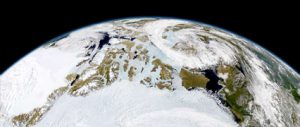Hedge-fund superstar David Harding has just made the biggest ever gift to the Cavendish Laboratory at Cambridge University: £20 million (more than US$30 million). But why would anyone want to give away such a sum, even if they had the cash to spare? For Harding, one reason was to compensate for all the physicists his firm had “poached” from the world of science, he said, only partly joking: his firm, Winton Capital Management, employs over 90 researchers with PhDs or other higher degrees, in subjects ranging from extragalactic astrophysics through to artificial intelligence.
But the two main reasons he decided to invest in the university where he himself studied theoretical physics were, first, he wants to help provide the “freedom to discover” – and, second, he sees a need to invest in the deep science that will help create low-carbon, low-impact technologies of the future.
Launching the Winton Programme for the Physics of Sustainability in March, Harding quipped that Winton Capital succeeds by outsourcing all the things in which it does not excel – and in this case, they were sub-contracting “the betterment of mankind”. The science is designed to underpin the transition to a sustainable global economy.
Fine, but why the unusual focus on physics? “While it is not quite as simple as using physics to save the world,” Harding explained, “this is an opportunity to use, for example, quantum physics to develop materials with seeming miraculous properties that could combat the growing effect humans are having on the planet.”
Although Harding didn’t use the term, materials research has often been the Cinderella of science, ignored despite its potential to blossom into something unexpected and extraordinary.
“In 2100, the sources of energy on this planet will be either solar or fusion, and the preferred means to transport and use energy will be electrical,” argued professor Peter Littlewood, who heads up the Cavendish Laboratory. “The ‘magic’ technologies needed to deliver this new age and make them available to societies worldwide are: photovoltaics, electrical storage, refrigeration and lighting.”
A key aim of the programme will be to “get organic materials to do things that Nature didn’t intend them to do,” said Sir Richard Friend, Cavendish Professor of Physics. In holding that post, he follows in the footsteps of some extremely distinguished scientists, including James Clerk Maxwell (who pioneered in electromagnetic theory), Ernest Rutherford (who pushed the frontiers of nuclear science) and Lawrence Bragg (whose work on X-ray crystallography helped crack the double-helix structure of DNA). More recently, the Cavendish Laboratory has pushed into new areas such as semiconductor science, the physics of medicine, nanotechnology, cold atoms and ultra-low temperature physics.
Professor Rutherford might turn in his grave to hear that the Winton Programme will largely turn its back on challenges to do with nuclear fission and fusion, but – whatever the reasoning – it probably makes good political sense in the context of recent events at Fukushima in Japan, with nuclear-plant operator Tepco joining BP as a byword for mismanagement and unsustainability.
Instead, at a time when scientists are able to manipulate and engineer materials at the level of individual atoms, creating new chemical structures and environments with novel properties, it is possible to “fine tune” materials by using extreme conditions of temperature, pressure and magnetic or electrical fields to hunt for emergent properties, such as superconductivity.
The ultimate aim in this field is to find superconductors that can carry electricity at astonishing levels of efficiency, while operating at or near room temperature – something that is currently impossible. Other goals include batteries with energy-storage properties that rival gasoline and new thermoelectric mechanisms that can scavenge heat from the environment.
As a group of us were guided around the laboratory’s different research units, we talked to scientists working on all sorts of materials-related challenges, among them the evolution of silicon inks that mean solar-energy collectors can be printed onto plastic sheeting and amazing new structures that could be building blocks for 3D memories, that can store and process massively greater amounts of data than is currently possible.
When I asked one of the Cavendish scientists how important the programme’s “sustainability” label was, he admitted that many of the experiments would have pushed ahead whatever label had been used – but that a lot of the scientists spotlighted the potential energy, raw material and environmental benefits of their research.
And even the world’s top physicists accept that they have a great deal to learn from nature, from biology and ecosystems. Biology, as they put it, studies the only natural examples of systems that operate at the nanoscale, “using nanomachines for everything from photosynthesis to the transfer of energy through cells”. The aim here will be to replace today’s “top-down fabrication with bottom-up self-assembly of structures, using natural systems for inspiration”.
One example we were shown was a project that uses nanofabrication to create identical copies of the scales that give the wonderful colours to butterfly wings, with the product covering areas of several square centimetres. Longer term, however, much of the challenge will involve producing materials that can be manufactured at low cost and used on a massive scale: using nanoscale products “that can be delivered by the tonne and by the hectare”.
The timescales being discussed are often in the decades. However, the Cavendish Laboratory is no stranger to urgent demands for new technologies in extraordinary circumstances. During the Second World War, for example, many of the Laboratory’s staff vanished into secret defence establishments – working on the development of such war-winning technologies as radar.
The hope now must be that we have the time necessary to develop and deploy the new technologies Cavendish is working towards – and that David Harding’s money will help keep more top scientists hard at work on the science, rather than vanishing into the much better paid world of high finance.
John Elkington is executive chairman of Volans and non-executive director at SustainAbility.
Homepage image from Argonne National Laboratory


